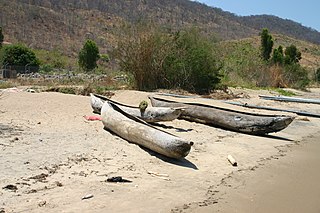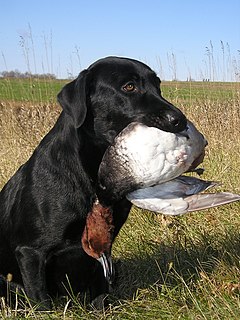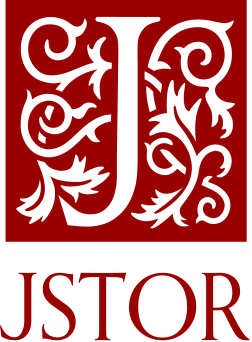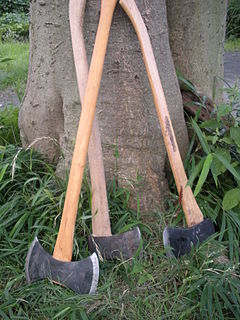A hound is a type of hunting dog used by hunters to track or chase prey.

A canoe is a lightweight narrow vessel, typically pointed at both ends and open on top, propelled by one or more seated or kneeling paddlers facing the direction of travel using a single-bladed paddle.

A dugout canoe or simply dugout is a boat made from a hollowed tree trunk. Other names for this type of boat are logboat and monoxylon. Monoxylon (μονόξυλον) is Greek -- mono- (single) + ξύλον xylon (tree) -- and is mostly used in classic Greek texts. In Germany they are called einbaum. Some, but not all, pirogues are also constructed in this manner.

A hunting dog is a canine that hunts with or for humans. There are several types of hunting dogs developed for various tasks and purposes. The major categories of hunting dogs include hounds, terriers, dachshunds, cur type dogs, and gun dogs. Further divisions can be made among these categories based upon the dogs' skillset and capabilities.

Torres Strait Islanders ( ) are the indigenous people of the Torres Strait Islands, part of Queensland, Australia. They are distinct from the Aboriginal people of the rest of Australia, and are generally referred to separately. There are also two Torres Strait Islander communities on the nearby coast of the mainland at Bamaga and Seisia.
There are several hundred Indigenous peoples of Australia; many are groupings that existed before the British colonisation of Australia in 1788. Within each country, people lived in clan groups: extended families defined by various forms of Australian Aboriginal kinship. Inter-clan contact was common, as was inter-country contact, but there were strict protocols around this contact.
Australian archaeology is a large sub-field in the discipline of archaeology. Archaeology in Australia takes three main forms, Aboriginal archaeology, historical archaeology and maritime archaeology. Bridging these sub-disciplines is the important concept of cultural heritage management which encompasses Aboriginal and Torres Strait Islander sites, historical sites and maritime sites.

The West Siberian Laika or WSL, is a breed of hunting dog and a breed of spitz type. Russian publications indicate that the term West Siberian Laika loosely applied to hunting dogs originating with the Mansi and Khanty people in Ural and West Siberia, but there were no standards or registrations of WSL as such until 1930. Then WWll disrupted it for a while, but systematic breeding with registrations resumed after the war ended, in 1946. This was the time the breed began taking modern shape. Before that hunters only knew of Mansi Laika and Khanty Laika. In early 1960 many hunters in Ural still preferred the term Mansi Laika, when speaking of West Siberian Laika. In Russian language, the term Laika originated from the word layat that means to bark. The word Laika simply means barker. Any hunting Laika is a bark pointer. It is a versatile dog depending on use and environment, but in certain parts of the country they have become more specialized.

A coolamon is an Australian Aboriginal carrying vessel.
Ship construction techniques can be categorized as one of hide, log, sewn, lashed-plank, clinker, shell-first, and frame-first. While the frame-first technique dominates the modern ship construction industry, the ancients relied primarily on the other techniques to build their watercraft. In many cases, these techniques were very labor-intensive and/or inefficient in their use of raw materials. Regardless of differences in ship construction techniques, the vessels of the ancient world, particularly those that plied the waters of the Mediterranean Sea and the islands of Southeast Asia were seaworthy craft, capable of allowing people to engage in large-scale maritime trade.

Traditionally, many different kinds of boats have been used as fishing boats to catch fish in the sea, or on a lake or river. Even today, many traditional fishing boats are still in use. According to the United Nations Food and Agriculture Organization (FAO), at the end of 2004, the world fishing fleet consisted of about 4 million vessels, of which 2.7 million were undecked (open) boats. While nearly all decked vessels were mechanised, only one-third of the undecked fishing boats were powered, usually with outboard engines. The remaining 1.8 million boats were traditional craft of various types, operated by sail and oars.
Dugong hunting in Australia is not prohibited; however, the practise is heavily regulated. Dugongs are protected throughout Australia, although the rules vary by state; in some areas indigenous hunting is allowed. Dugongs are listed under the Nature Conservation Act in the Australian state of Queensland as vulnerable. Most currently live in established marine parks, where boats must travel at a restricted speed and mesh net fishing is restricted.

The Quandamooka people are an Aboriginal Australian group that live around Moreton Bay in Southeastern Queensland. They are composed of three distinct tribes, the Nunukul, the Goenpul and the Ngugi, and they live primarily on Moreton and North Stradbroke Islands, that form the eastern side of the bay. Many of them were pushed out of their lands when the English colonial government established a penal colony near there in 1824. Each group has its own language. A number of local food sources are utilised by the tribes.
The Yuwi or Yuibera are an Indigenous Australian people, originating from Mackay, Queensland, Australia.
Mua people (Mualgal) alternatively the Moa, are an indigenous Australian Torres Strait Island people based on Moa(Banks Island). According to Alfred Cort Haddon their lifestyle, culture, myths and kinship networks overlapped closely with those of the Kaurareg on neighbouring Muralag.
The Barungguan are an indigenous Australian people of the Cape York Peninsula of Northern Queensland. The name is associated with three languages, Ganganda, Umpithamu and Morrobolam.
The Pakadji people, also known by the southern tribal exonym as the Koko Yao, were an Indigenous Australian group of Cape York Peninsula in northern Queensland. The ethnonym Koko Ya'o is said literally to mean 'talk, speech' (koko/kuku) 'this way' (ya'o), though this has been questioned.
The Night Island Kawadji, or Uutaalnganu, were an Indigenous Australian group of Cape York Peninsula in northern Queensland. The name, which means is also used collectively for several tribes in this area, such as the Pontunj / Jangkonj (Yanganyu), whose language is unconfirmed.

In computing, a Digital Object Identifier or DOI is a persistent identifier or handle used to uniquely identify objects, standardized by the International Organization for Standardization (ISO). An implementation of the Handle System, DOIs are in wide use mainly to identify academic, professional, and government information, such as journal articles, research reports and data sets, and official publications though they also have been used to identify other types of information resources, such as commercial videos.

JSTOR is a digital library founded in 1995. Originally containing digitized back issues of academic journals, it now also includes books and other primary sources, and current issues of journals. It provides full-text searches of almost 2,000 journals. As of 2013, more than 8,000 institutions in more than 160 countries had access to JSTOR; most access is by subscription, but some of the site's public domain and open access content is available at no cost to anyone. JSTOR's revenue was $86 million in 2015.

The Royal Anthropological Institute of Great Britain and Ireland (RAI) is a long-established anthropological organisation, with a global membership. Its remit includes all the component fields of anthropology, such as biological anthropology, evolutionary anthropology, social anthropology, cultural anthropology, visual anthropology and medical anthropology, as well as sub-specialisms within these, and interests shared with neighbouring disciplines such as human genetics, archaeology and linguistics. It seeks to combine a tradition of scholarship with services to anthropologists, including students.
















